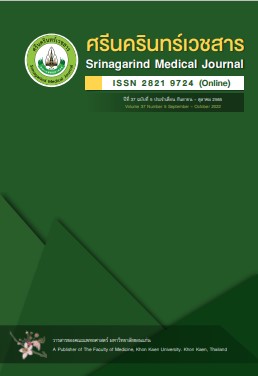ภาวะหัวใจเต้นช้ากว่าปกติจากการได้รับ 5-fluorouracil: กรณีศึกษา
คำสำคัญ:
5-Fluorouracil, antimetabolite, chemotherapy, cardiotoxicity, bradycardiaบทคัดย่อ
หลักการและวัตถุประสงค์: การเกิดภาวะแทรกซ้อนต่อหัวใจ เป็นอาการไม่พึงประสงค์หนึ่งที่พบได้จากการได้รับ 5-fluorouracil (5-FU) อาการทางคลินิกซึ่งสัมพันธ์กับการใช้ 5-FU ที่อาจพบได้ เช่น ภาวะเจ็บเค้นอก, ใจสั่น, อาการหายใจลำบาก, ภาวะกล้ามเนื้อหัวใจตาย, ภาวะช็อกจากเหตุหัวใจ และ ภาวะหัวใจหยุดเต้นเฉียบพลัน เป็นต้น แม้ว่าจะพบการเกิดความผิดปกติของคลื่นหัวใจโดยไม่มีอาการแสดง อย่างไรก็ตามภาวะหัวใจเต้นช้ากว่าปกติมักเป็นอาการที่มักไม่ถูกรายงาน รายงานกรณีศึกษานี้จึงมีวัตถุประสงค์เพื่อรายงานผู้ป่วยที่เกิดภาวะหัวใจเต้นช้ากว่าปกติโดยไม่มีอาการแสดงจากการได้รับการรักษาด้วย 5-FU
กรณีศึกษา: ผู้ป่วยหญิงอายุ 47 ปีซึ่งมีโรคประจำตัวเป็นโรคหัวใจที่มีโครงสร้างหัวใจผิดปกติ ได้รับการวินิจฉัยว่าเป็นมะเร็งเยื่อบุโพรงมดลูกระยะ 4B เมื่อ 9 เดือนที่ผ่านมา โรคหัวใจของผู้ป่วยซึ่งได้รับการตรวจก่อนให้การรักษาด้วยยาเคมีบำบัดอยู่ในภาวะคงที่ อย่างไรก็ตามในวันที่ 3 ของการให้ยาเคมีบำบัดแบบประคับประคอง (รอบที่ 1) ด้วย 5-FU ขนาด 1000 มิลลิกรัม/ตารางเมตร ผู้ป่วยได้เกิดภาวะหัวใจเต้นช้ากว่าปกติโดยไม่มีอาการแสดง ซึ่งหลังจากเกิดเหตุการณ์ดังกล่าว ได้มีการหยุดยา 5-FU และไม่มีการให้ยาดังกล่าวอีก
สรุป: การเกิดภาวะหัวใจเต้นช้ากว่าปกติจาก 5-FU ถือเป็นอาการไม่พึงประสงค์ต่อหัวใจที่พบได้ไม่บ่อยนัก ผู้ป่วยที่มีโรคประจำตัวเป็นโรคหัวใจ ควรได้รับการประเมินโรคและปัจจัยเสี่ยงของการเกิดโรคหัวใจและหลอดเลือดก่อนเริ่มการรักษา นอกจากนี้การติดตามผู้ป่วยอย่างใกล้ชิดด้วยการตรวจคลื่นไฟฟ้าหรือการติดเครื่องบันทึกคลื่นไฟฟ้าหัวใจแบบพกพาก็มีความจำเป็นเช่นกัน เมื่อเกิดเหตุการณ์ดังกล่าวควรหยุด 5-FU ทันที การให้ยา 5-FU แก่ผู้ป่วยอีกครั้งสามารถทำได้ในผู้ป่วยบางรายที่มีอาการไม่รุนแรงเท่านั้น อย่างไรก็ตามควรมีการประเมินความเสี่ยงกับประโยชน์ที่ได้รับก่อนทำการให้ยาอีกครั้ง
เอกสารอ้างอิง
Jurczyk M, Król M, Midro A, Kurnik-Łucka M, Poniatowski A, Gil K. Cardiotoxicity of Fluoropyrimidines: Epidemiology, Mechanisms, Diagnosis, and Management. J Clin Med 2021;10(19).
Lee AD, McKay MJ. Symptomaitc 5-fluorouracil-induced sinus bradycardia. Intern Med J 2011;41(7):566-70.
Meyer CC, Calis KA, Burke LB, Walawander CA, Grasela TH. Symptomatic cardiotoxicity associated with 5-fluorouracil. Pharmacotherapy 1997;17(4):729-36.
Tsavaris N, Kosmas C, Vadiaka M, Efremidis M, Zinelis A, Beldecos D, et al. Cardiotoxicity following different doses and schedules of 5-fluorouracil administration for malignancy-a survey of 427 patients. Med Sci Monit 2002;8(6):PI51-7.
Wacker A, Lersch C, Scherpinski U, Reindl L, Seyfarth M. High incidence of angina pectoris in patients treated with 5-fluorouracil. A planned surveillance study with 102 patients. Oncology 2003;65(2):108-12.
Talapatra K, Rajesh I, Rajesh B, Selvamani B, Subhashini J. Transient asymptomatic bradycardia in patients on infusional 5-fluorouracil. J Cancer Res Ther 2007;3(3):169-71.
Kosmas C, Kallistratos MS, Kopterides P, Syrios J, Skopelitis H, Mylonakis N, et al. Cardiotoxicity of fluoropyrimidines in different schedules of administration: a prospective study. J Cancer Res Clin Oncol 2008;134(1):75-82.
Stewart T, Pavlakis N, Ward M. Cardiotoxicity with 5-fluorouracil and capecitabine: more than just vasospastic angina. Intern Med J 2010;40(4):303-7.
Khan MA, Masood N, Husain N, Ahmad B, Aziz T, Naeem A. A retrospective study of cardiotoxicities induced by 5-fluouracil (5-FU) and 5-FU based chemotherapy regimens in Pakistani adult cancer patients at Shaukat Khanum Memorial Cancer Hospital & Research Center. J Pak Med Assoc 2012;62(5):430-4.
Lestuzzi C, Vaccher E, Talamini R, Lleshi A, Meneguzzo N, Viel E, et al. Effort myocardial ischemia during chemotherapy with 5-fluorouracil: an underestimated risk. Ann Oncol 2014;25(5):1059-64.
Hafeez I, Lone AA, Beig J, Alai M, Dar M, Tramboo N. Effect of 5-fluorouracil on sinoatrial node and conduction system of heart. J Adv Med Med Res 2017;4:184.
Peng J, Dong C, Wang C, Li W, Yu H, Zhang M, et al. Cardiotoxicity of 5-fluorouracil and capecitabine in Chinese patients: a prospective study. Cancer Commun (Lond) 2018;38(1):22.
Osterlund P, Kinos S, Pfeiffer P, Salminen T, Kwakman JJM, Frödin JE, et al. Continuation of fluoropyrimidine treatment with S-1 after cardiotoxicity on capecitabine- or 5-fluorouracil-based therapy in patients with solid tumours: a multicentre retrospective observational cohort study. ESMO Open 2022;7(3):100427.
Lestuzzi C, Tartuferi L, Viel E, Buonadonna A, Vaccher E, Berretta M. Fluoropyrimidine-Associated Cardiotoxicity: Probably Not So Rare As It Seems. Oncologist 2020;25(8):e1254.
Jin X, Bai Y, Gao L, Wu S. Incidence of and risk factors for cardiotoxicity after fluorouracil-based chemotherapy in locally advanced or metastatic gastric cancer patients. Cancer Chemother Pharmacol 2019;84(3):599-607.
Jensen SA, Hasbak P, Mortensen J, Sørensen JB. Fluorouracil induces myocardial ischemia with increases of plasma brain natriuretic peptide and lactic acid but without dysfunction of left ventricle. J Clin Oncol 2010;28(36):5280-6.
Yuan C, Parekh H, Allergra C, George TJ, Starr JS. 5-FU induced cardiotoxicity: case series and review of the literature. Cardiooncology 2019;5:13.
Kanduri J, More LA, Godishala A, Asnani A. Fluorouracil-Associated Cardiotoxicity. Cardiol Clin 2019;37(4):399-405.
Sara JD, Kaur J, Khodadadi R, Rehman M, Lobo R, Chakrabarti S, et al. 5-fluorouracil and ancrdiotoxicity: a review. Ther Adr Med Oncol 2018;10.
Layoun ME, Wickramasinghe CD, Peralta MV, Yang EH. Fluoropyrimidine-Induced Cardiotoxicity: Manifestations, Mechanisms, and Management. Curr Oncol Rep 2016;18(6):35.
Jensen SA, Sørensen JB. Risk factors and prevention of cardiotoxicity induced by 5-fluorouracil or capecitabine. Cancer Chemother Pharmacol 2006;58(4):487-93.
Tsavaris N, Kosmas C, Vadiaka M, Skopelitis E, Kopterides P, Pamouki S, et al. 5-Fluorouracil cardiotoxicity is a rare, dose and schedule-dependent adverse event: A prospective study. J BUON 2005;10:205-11.
Clasen SC, Ky B, O’Quinn R, Giantonio B, Teitelbaum U, Carver JR. Fluoropyrimidine-induced cardiac toxicity: challenging the current paradigm. J Gastrointest Oncol 2017;8(6):970-9.
Redman JM, Rhea L, Brofferio A, Whelpley M, Gulley JL, Gatti-Mays ME, et al. Successful 5-fluorouracil (5-FU) infusion re-challenge in a metastatic colorectal cancer patient with coronary artery disease who experienced symptoms consistent with coronary vasospasm during first 5-FU infusion. J Gastrointest Oncol 2019;10(5):1010-4.
ดาวน์โหลด
เผยแพร่แล้ว
รูปแบบการอ้างอิง
ฉบับ
ประเภทบทความ
สัญญาอนุญาต
ลิขสิทธิ์ (c) 2022 ศรีนครินทร์เวชสาร

อนุญาตภายใต้เงื่อนไข Creative Commons Attribution-NonCommercial-NoDerivatives 4.0 International License.




